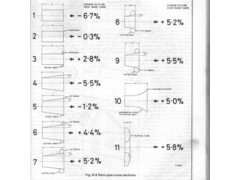02GF74
|
| posted on 8/6/06 at 01:39 PM |

|
|
simpleton air trumpet query
someone recently got his old boy neighbour to make a lovely set of brass trumpets that got me wondering.....
Delloto DCOE trumpets are around £ 15 each so at £ 60 for a full set, fall out of the low cost category. 
Now I should have the technology (read ali sheet, lumiweld & glue) to make a base plate and attach a cone so .....
a) how critical is the shape - i.e. will a cylinder be ok or does it need to be tapering cone of the correct shape?
b) the bell mount - are flared edges essential or can they be left straight?
To summarise: if I put a say 30 mm long cylindrical trumpets (so they fit inside the filters) is that better (?) than leaving the carbs with no
trumpets and what benefits will there be (i.e. is it worth the bother)?
|
|
|
|
|
muzchap
|
| posted on 8/6/06 at 02:07 PM |

|
|
You can get em for £5.00 each
www.performancecentre.co.uk
Search by BRAND
Select ITG
Select RAM PIPES
Aluminium Spun AH-32 £5 each 
------------------------------------
If you believe you're not crazy, whilst everybody is telling you, you are - then they are definitely wrong!
------------------------------------
|
|
|
02GF74
|
| posted on 8/6/06 at 02:36 PM |

|
|
ah, naybe I should have mentioned they are 40 DCOE ... all those spun trumpets are way too big , nice try though.
I wonder how big are those min pepsi can things 
|
|
|
muzchap
|
| posted on 8/6/06 at 03:54 PM |

|
|
They do DCOE as well 
------------------------------------
If you believe you're not crazy, whilst everybody is telling you, you are - then they are definitely wrong!
------------------------------------
|
|
|
DIY Si
|
| posted on 8/6/06 at 03:55 PM |

|
|
The shape is of utmost importance unfortunately. The open end must be rolled back over or you lose any benefits. A straight ram pipe with a squared
off end will flow less air than the open carb probably will. Not sure what this chart uses as a base carb, probably su's, but you get the
idea.
 
Rescued attachment ram-pipe-flow.jpg
|
|
|
02GF74
|
| posted on 8/6/06 at 04:37 PM |

|
|
thanks Si. that exactly answer my question; guess I need to start saving 
(or find a D shaped O ring of the right size)
|
|
|
iank
|
| posted on 8/6/06 at 09:06 PM |

|
|
Didn't realise Stub-stacks (number 11, the D shaped O-ring  ) flowed so well. But flow isn't the whole story as mentioned elsewhere the
length moves where the engine makes most power and torque. ) flowed so well. But flow isn't the whole story as mentioned elsewhere the
length moves where the engine makes most power and torque.
K&N make stub-stacks IIRC and they fit in filters really well obviously.
[Edited on 8/6/06 by iank]
|
|
|
DIY Si
|
| posted on 8/6/06 at 09:10 PM |

|
|
Admittedly it's not all about air flow, but the overall shape remains the same. For a mini running su's the best vizard found was actually
28" long! But there is a trade off. Generally though, something around 30-40mm long will do nicely. And having fitted soem stub stacks to cars
in the past, they make a shocking difference for such a small thing. It's all about the rounded edges and smooth flowing shapes. Just like head
porting etc. But there is a trade off. Generally though, something around 30-40mm long will do nicely. And having fitted soem stub stacks to cars
in the past, they make a shocking difference for such a small thing. It's all about the rounded edges and smooth flowing shapes. Just like head
porting etc.
|
|
|
bimbleuk
|
| posted on 9/6/06 at 09:06 AM |

|
|
Dont discount the flat baffle plate behind the the trumpet opening either. moving this up and down the length of the trumpet stem can also have an
effect.
|
|
|
JB
|
| posted on 9/6/06 at 02:51 PM |

|
|
Perfect Reply
DiySi,
You have given the perfect reply and that page in Vizards book was exactly what I was thinking.
Even if you never intend to tune an A Series Engine the book is worth reading, as is ANY thing written by David Vizard
John
|
|
|
DIY Si
|
| posted on 9/6/06 at 05:01 PM |

|
|
Thank you kind sir! I used it to tune my mini to 150 bhp (naturally aspirated) and still use it as a referene for just about any engine, as most of
the principles still stand. I used it to tune my mini to 150 bhp (naturally aspirated) and still use it as a referene for just about any engine, as most of
the principles still stand.
|
|
|













